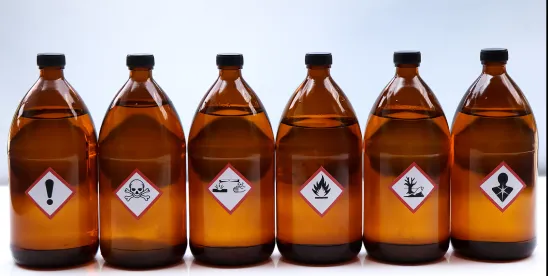On May 20, 2024, the U.S. Occupational Safety & Health Administration (OSHA) issued a final rule updating its Hazard Communication Standard (HCS) (29 CFR 1910.1200). The final rule takes effect July 19, 2024.
OSHA’s HCS aims to ensure chemical safety in the workplace by requiring chemical manufacturers or importers to classify the hazards of chemicals they produce or import. In addition, the HCS requires all employers, including those with manufacturing, industrial, retail, medical, and technical establishments, to provide information to their employees about the hazardous chemicals to which they are exposed.
HCS is one of the most common types of violations OSHA cites every year, and noncompliance can be costly for a company. For example, OSHA recently issued nearly $300,000 in penalties to a chemical manufacturing and technology company for, among other things, failing to provide information and training to all employees who were assigned to workplaces where there was exposure to hazardous chemicals as required by the HCS. Specifically, the company failed to maintain a list of hazardous chemicals known to be present at the worksite; ensure that chemical containers were properly labeled, tagged, or marked with the product identifier; and ensure that each employee had access to safety data sheets (SDS) providing specific information about the physical and health risks of the chemicals.
OSHA promulgated its original HCS in 1983 to provide a standardized approach to workplace hazard communications associated with hazardous chemical exposure. OSHA updated the standard in 2012 to align with the United Nations’ Globally Harmonized System of Classification and Labelling of Chemicals (GHS), which has been implemented around the world, to provide a common and coherent approach to classifying chemicals and communicating hazard information to employees.
The Final Rule
The final rule includes the following changes and reinforces many of the key principles and requirements in the current HCS:
- implements updates to align with other U.S. agencies and international trading partners, and the most recent revisions to the GHS, and further enhances the effectiveness of the standard.
- makes clear that the purpose of the standard is “to ensure that the hazards of all chemicals produced or imported are classified, and that information concerning the classified hazards is transmitted to employers and employees.”
- clarifies that the only chemicals which are excluded from the scope of the standard are those the chemical manufacturer or importer can establish do not pose any physical hazard, health hazard, or other hazards covered under the HCS.
- requires chemical manufacturers, importers, distributors, or employers to develop, implement, and maintain a written hazard communication program, and make the program available, upon request, to employees, their designated representatives, and OSHA.
- reinforces that all employers with hazardous chemicals in the workplace must develop and maintain a written hazard communication program, which, at a minimum, contains a list of the hazardous chemicals known to be present using a product identifier that is referenced on an appropriate SDS. The program should also include the methods the employer will use to inform employees of the risks associated with the chemicals contained in their work areas.
- streamlines the criteria that must be contained on labels and SDSs to provide important safety information to employers and employees on the use of hazardous chemicals in the workplace, and provide detailed technical information to employees and others who are exposed.
- allows a company to withhold, under limited circumstances, concentration ranges of substances for reasons related to trade secrets.
- sets forth the requirements for chemical manufacturers and importers to evaluate the hazards of chemicals present in the workplace or being imported to determine the hazard classes, and where appropriate, the category of each class that applies to the chemical being classified.
- requires all employers to maintain copies of the required SDSs for each hazardous chemical present in the workplace and ensure they are readily accessible to employees when they are in their work areas.
- requires employers to provide employees with effective training on hazardous chemicals in their work area at the time of their initial assignment, and whenever a new chemical hazard is introduced into a work area.
.
Takeaways
On the production floor, labels and SDSs typically are employees’ main source of information concerning the hazards of what they are working with, and the potentially necessary precautions, such as personal protective equipment. Accordingly, manufacturers, importers, distributors, and employers should provide accurate information, based on all available evidence, of the hazards associated with a particular chemical so that workers know how to adequately protect themselves and safely handle chemicals.
Failure to have required SDSs “readily accessible” is a common safety concern for OSHA. In this regard, the final rule specifically permits electronic access to SDSs if employees are faced with no barriers to immediate access to the digital SDSs (such as proximity to a computer, or an unknown password) and workers are able to immediately provide copies of SDSs to medical personnel when necessary.
To mitigate the likelihood of a HCS violation, employers should consider taking the following steps:
- familiarize themselves with the applicable requirements of the standard and updates in the final rule and identify the staff members responsible for developing and implementing a written Hazard Communication Program,
- prepare a list or inventory of all hazardous chemicals in the workplace, evaluate the hazards of any chemicals introduced into the workplace, obtain labels and SDSs, and provide HCS training to employees, and
- ensure that employees have access to the required safety materials and are trained to safely handle hazardous chemicals present at the worksite.
By proactively complying with this final rule, companies can ensure employees have the appropriate information about the chemical hazards to which they may be exposed, likely reducing the incidence of chemical-related occupational illnesses and injuries.




 />i
/>i

